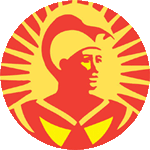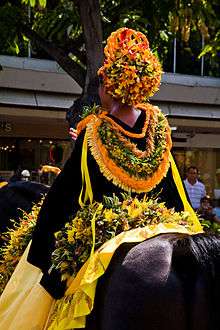Aloha Festivals
| Aloha Festivals | |
|---|---|
 Aloha Festivals | |
| Status | Active |
| Genre | Festivals |
| Frequency | Annually |
| Venue | State-wide |
| Location(s) | Hawaii |
| Country | USA |
| Years active | 1946- |
| Inaugurated | 1946 |
| Founder | Former members of the local Junior Chamber of Commerce |
| Most recent | 2009 |
| Participants | 30,000 |
| Attendance | 1,000,000 |
| Activity | Concerts, parades, street parties |
The Aloha Festivals are an annual series of free cultural celebrations observed in the state of Hawaii in the United States. It is the only statewide cultural festival in the nation. It features concerts, parades, street parties called ho‘olaule‘a as well as various other special events planned for resident and tourist families. The festivals used to be multi-island, but it has since been scaled down to just the island of Oahu.
Establishment
In the spirit of preserving the Hawaiian culture and heritage, the Aloha Festivals were established in 1946 as Aloha Week by former members of the local Junior Chamber of Commerce. The former manager of the festivals, Goriann Akau, has said, "In 1946, after the war, Hawaiians needed an identity. We were lost and needed to regroup. When we started to celebrate our culture, we began to feel proud. We have a wonderful culture that had been buried for a number of years. This brought it out again. Self-esteem is more important than making a lot of money."[1] Aloha Festivals now consists of 4 festivals events during the month of September and highlights are the presentation of the Royal Court, a block party with vendors and performers in the heart of Waikiki, and the Floral Parade which marches from Ala Moana Boulevard down through Kalakaua Avenue. Approximately 30,000 people volunteer to plan, organize, and provide labor for the Aloha Festivals each year. Their efforts entertain over 1,000,000 people from throughout the state and visitors from all over the world.
Themes
Each year has a specific theme:
- 2015: Hula Aloha ("Beloved Feather Treasures")
- 2010-14: ? (info needed for these years)
- 2009: Hula ("Let the Story Be Told")
- 2008: Hula ("The Art of Hawaiian Dance")
- 2005: Nā Honu Hawaiʻi ("The Spirit Within")
- 2004: No Nā Kamaliʻi ("For the Children")
- 2003: E Mau Ana Ka Hula I Ke Kanaka ("Hula Lives Through Its People")
- 2002: Ka ʻUhane O Ka Loea ("The Spirit of the Masters")
- 2001: Hoʻohanohano I Nā Holokai ("Honor the Voyagers")
- 2000: He Makana O Nā Lei Nani ("A Gift of Beautiful Leis")
- 1999: Hui Pū I ka Hula ("Together in Song and Dance")
- 1998: Ola Ka ʻŌiwi ("The Natives Endure")
See also
References
- ↑ Foster, Jeanette (7 July 2011). Frommer's Maui 2012. John Wiley & Sons. p. 31. ISBN 978-1-118-10069-1. Retrieved 29 April 2012.


